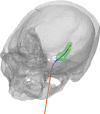Optimization of Curvilinear Needle Trajectories for Transforamenal Hippocampotomy
- PMID: 28580377
- PMCID: PMC5453508
- DOI: 10.1227/NEU.0000000000001361
Optimization of Curvilinear Needle Trajectories for Transforamenal Hippocampotomy
Abstract
Background: The recent development of MRI-guided laser-induced thermal therapy (LITT) offers a minimally invasive alternative to craniotomies performed for tumor resection or for amygdalohippocampectomy to control seizure disorders. Current LITT therapies rely on linear stereotactic trajectories that mandate twist-drill entry into the skull and potentially long approaches traversing healthy brain. The use of robotically-driven, telescoping, curved needles has the potential to reduce procedure invasiveness by tailoring trajectories to the curved shape of the ablated structure and by enabling access through natural orifices.
Objective: To investigate the feasibility of using a concentric tube robot to access the hippocampus through the foramen ovale to deliver thermal therapy and thereby provide a percutaneous treatment for epilepsy without drilling the skull.
Methods: The skull and both hippocampi were segmented from dual CT/MR image volumes for 10 patients. For each of the 20 hippocampi, a concentric tube robot was designed and optimized to traverse a trajectory from the foramen ovale to and through the hippocampus from head to tail.
Results: Across all 20 cases, the mean distances (error) between hippocampus medial axis and backbone of the needle were 0.55 mm, 1.11 mm, and 1.66 mm for best, mean, and worst case, respectively.
Conclusion: These curvilinear trajectories would provide accurate transforamenal delivery of an ablation probe to typical hippocampus volumes. This strategy has the potential to both decrease the invasiveness of the procedure and increase the completeness of hippocampal ablation.
Keywords: Skull base; ablation; epilepsy surgery; interventional MRI; nonlinear trajectory; robotic needle.
Figures







Similar articles
-
Accuracy, Effectiveness, and Safety of Robot-Assisted Magnetic Resonance Imaging-Guided Laser Interstitial Thermal Therapy for Treatment of Drug-Resistant Epilepsy: A Systematic Review and Meta-Analysis.World Neurosurg. 2025 Mar;195:123640. doi: 10.1016/j.wneu.2024.123640. Epub 2025 Feb 10. World Neurosurg. 2025. PMID: 39827953
-
In Vivo Safety and Feasibility of a CT-Guided Robotic Device for Percutaneous Needle Placement in Bone.J Vasc Interv Radiol. 2025 May;36(5):877-883.e1. doi: 10.1016/j.jvir.2025.01.031. Epub 2025 Jan 21. J Vasc Interv Radiol. 2025. PMID: 39848322
-
Robot-Assisted CT-Guided Biopsy with an Artificial Intelligence-Based Needle-Path Generator: An Experimental Evaluation Using a Phantom Model.J Vasc Interv Radiol. 2025 May;36(5):869-876. doi: 10.1016/j.jvir.2025.01.028. Epub 2025 Jan 21. J Vasc Interv Radiol. 2025. PMID: 39848324
-
[Volume and health outcomes: evidence from systematic reviews and from evaluation of Italian hospital data].Epidemiol Prev. 2013 Mar-Jun;37(2-3 Suppl 2):1-100. Epidemiol Prev. 2013. PMID: 23851286 Italian.
-
Development of a Low-Profile, Piezoelectric Robot for MR-Guided Abdominal Needle Interventions.Ann Biomed Eng. 2025 Jul;53(7):1638-1650. doi: 10.1007/s10439-025-03719-w. Epub 2025 Apr 23. Ann Biomed Eng. 2025. PMID: 40266438
Cited by
-
Interactive Multi-Stage Robotic Positioner for Intra-Operative MRI-Guided Stereotactic Neurosurgery.Adv Sci (Weinh). 2024 Feb;11(7):e2305495. doi: 10.1002/advs.202305495. Epub 2023 Dec 10. Adv Sci (Weinh). 2024. PMID: 38072667 Free PMC article.
-
Dual-echo Z-shimmed proton resonance frequency-shift magnetic resonance thermometry near metallic ablation probes: Technique and temperature precision.Magn Reson Med. 2017 Dec;78(6):2299-2306. doi: 10.1002/mrm.26634. Epub 2017 Feb 10. Magn Reson Med. 2017. PMID: 28185304 Free PMC article.
-
Automated Steerable Path Planning for Deep Brain Stimulation Safeguarding Fiber Tracts and Deep Gray Matter Nuclei.Front Robot AI. 2019 Aug 6;6:70. doi: 10.3389/frobt.2019.00070. eCollection 2019. Front Robot AI. 2019. PMID: 33501085 Free PMC article.
-
MRI Robots for Needle-Based Interventions: Systems and Technology.Ann Biomed Eng. 2018 Oct;46(10):1479-1497. doi: 10.1007/s10439-018-2075-x. Epub 2018 Jun 19. Ann Biomed Eng. 2018. PMID: 29922958 Free PMC article.
-
Targeting Epilepsy Through the Foremen Ovale: How Many Helical Needles are Needed?Ann Biomed Eng. 2022 May;50(5):499-506. doi: 10.1007/s10439-022-02929-w. Epub 2022 Mar 4. Ann Biomed Eng. 2022. PMID: 35244812 Free PMC article.
References
-
- Wiebe S, Bellhouse DR, Fallahay C, Eliasziw M. Burden of epilepsy: the Ontario Health Survey. Can J Neurol Sci. 1999;26(4):263–270. - PubMed
-
- Engel J JrWiebe SFrench J. et al. Practice parameter: temporal lobe and localized neocortical resections for epilepsy. Epilepsia. 2003;44(6):741–751. - PubMed
-
- Kwan P, Brodie MJ. Early identification of refractory epilepsy. N Engl J Med. 2000;342(5):314–319. - PubMed
-
- Hori T, Yamane F, Ochiai T, Hayashi M, Taira T. Subtemporal amygdalohippocampectomy prevents verbal memory impairment in the language-dominant hemisphere. Stereotact Funct Neurosurg. 2003;80(1-4):18–21. - PubMed
-
- Lutz MT, Clusmann H, Elger CE, Schramm J, Helmstaedter C. Neuropsychological outcome after selective amygdalohippocampectomy with transsylvian versus transcortical approach: a randomized prospective clinical trial of surgery for temporal lobe epilepsy. Epilepsia. 2004;45(7):809–816. - PubMed
Publication types
MeSH terms
Grants and funding
LinkOut - more resources
Full Text Sources
Other Literature Sources

